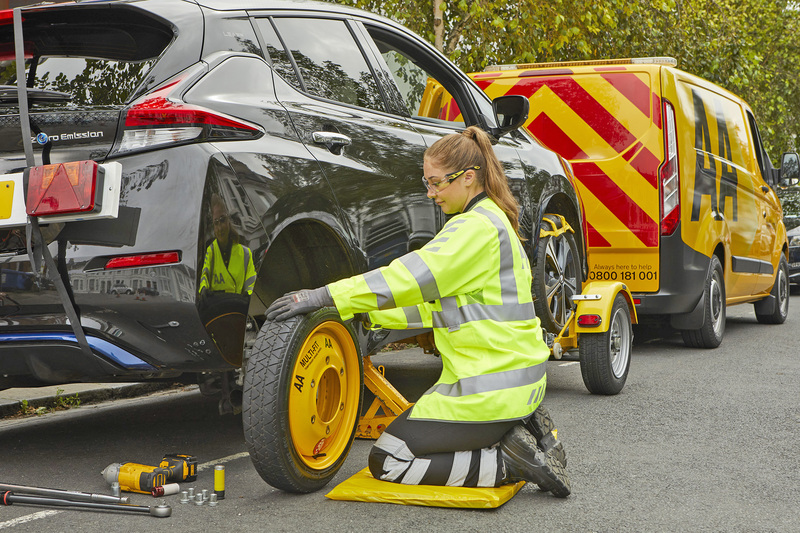The AA aims to provide more than breakdown cover for its fleet customers and is investing heavily in Prestige – its service, maintenance, and repair (SMR) offering.
Gavin Franks, director of business services at the AA, says he sees an “exciting opportunity” to join up the roadside and SMR elements of the organisation’s services.
“The exciting thing we are trying to do is provide that end-to-end solution support for fleets, looking at how we manage an incident from start-to-finish, rather than just being the breakdown provider,” Franks says.
“So, if anything goes wrong, whether it’s planned or unplanned maintenance or an accident, we can quickly get the vehicle through whatever repair network it needs or fixed at the side of the road if it’s just roadside, then back into the fleet as quickly as possible.
“We’re also growing our accident management business – our existing accident management business has been subscale, but we’ve invested in a new platform.”
Two key areas the AA continues to invest in are electric vehicles (EVs) and connected vehicles.
“We believe we are at a point where we have the best trained workforce out there - so we’ve trained all our patrols to a Level 2 capability in terms of EV,” says Franks.
The AA aims to provide more than breakdown cover for its fleet customers and is investing heavily in Prestige – its service, maintenance, and repair (SMR) offering.
Gavin Franks, director of business services at the AA, says he sees an “exciting opportunity” to join up the roadside and SMR elements of the organisation’s services.
“The exciting thing we are trying to do is provide that end-to-end solution support for fleets, looking at how we manage an incident from start-to-finish, rather than just being the breakdown provider,” Franks says.
“So, if anything goes wrong, whether it’s planned or unplanned maintenance or an accident, we can quickly get the vehicle through whatever repair network it needs or fixed at the side of the road if it’s just roadside, then back into the fleet as quickly as possible.
“We’re also growing our accident management business – our existing accident management business has been subscale, but we’ve invested in a new platform.”
Supporting EV breakdowns
Two key areas the AA continues to invest in are electric vehicles (EVs) and connected vehicles.
“We believe we are at a point where we have the best trained workforce out there - so we’ve trained all our patrols to a Level 2 capability in terms of EV,” says Franks.
“We have some Level 3 trained patrols, but all our patrols are officially trained to Level 2. We are considering additional Level 3 training over the coming 12 months, now we have completed our Level 2 courses.
“We are also looking at the tool sets we need to provide our patrols with, because, although there’s a big (negative) perception around EV range, the actual volume of breakdowns that are range-related is very low – it’s about 4%, which is on a par with what we see with running out of fuel, which is about 1-2%.
“As technology evolves, we’re starting to look at how we start to test it, as there will come a time where on-board EV chargers are fit for purpose. We do see a role for them, so we’re starting to look at some of those trials.”
The AA has a concept van equipped with an onboard charger, that doesn’t require an engine or generator running to charge an EV. The van is also capable of hydrogen refuelling.
“We’re starting to look at this concept of how we specialise around EV breakdowns, rather than universally training everybody given the volumes of breakdowns on EVs are going to stay relatively small over the near future given the (low) percentage of the car parc,” says Franks.
“It’s about how do we try to have a focus team that can deal with an EV breakdown in any of its forms - whether it’s out of charge, a material issue, a user issue – having the expertise within that team who can deal with that. I think next year is probably going to be the year where we start to look at a more focused EV support team.”
Connected vehicles
Diagnosing breakdowns before they occur with connected vehicles is also an area the AA aims to focus on.
“Through connected vehicles, we’ll be able to fix more remotely and prevent a breakdown happening in the first place,” Frank says.
“We can spot the degradation in advance through connected data that will allow us to contact the customer and give them the best options to suit their needs.
“Fleet is one of the areas where we see an early opportunity as we can get permission en masse and really start to drive it as many fleets already have telematics devices fitted within their vehicles to help manage driver behaviour.”
Freewheeling Hub
Last January, the AA launched its Freewheeling Hub, an addition to its Multi-Fit Wheel Kit, with the technology rolled out to all patrols at the end of March 2021. The hub is being used up to 20 times per day with more than 2,000 deployments since July 2021.
The tool provides a way for patrols to safely tow EVs, 4x4s and SUVs, which normally cannot be ‘lifted’ and towed on two wheels.
As well as rescuing EVs, the Freewheeling Hub can be fixed to the rear wheels of stricken vehicles, so they can be towed, rather than having to a wait for a flatbed recovery vehicle.
The technology has helped business customers reduce downtime and gives fleets confidence to invest in their EV capabilities.
“There are many aspects to transitioning a fleet from internal combustion engine (ICE) vehicles to EVs,” Franks said.
“The benefit of our Freewheeling Hub is that is deployed to all of our patrols, so our ability to support fleets means we’re getting that consistent experience, as the way we recover vehicles will be consistently applied with a single process.
“Our patrols are very good at creating solutions to individual problems they come across, but I think over time that will evolve and develop, and we’ll have different things that will add into that solution set that will give us more flexibility as vehicles change and evolve,” Franks says.
The AA’s EV support service also includes providing customers with charge point support from a dedicated call centre.
Franks says: “We have this capability that we’ve set up with charge point providers that can support people at charge points.
“We can talk customers through what they need to do if the charge point isn’t working and if it’s fundamentally broken, we can arrange for repair and we’re extending the capability so we can go out and check on them as well.
“It’s given us a lot of insight in terms of EV behaviours, both on the challenges and usability issues and insight into certain vehicles, for example, which ones will have a recurring problem.
“For us it’s about providing the best support, but it’s also about collecting the insights so we can share back and improve charge point usability.”
Fleet customer partnership plus innovation in mobility technology: Winners – the AA
Judges’s comment:
Fleet Customer Partnership Award
By influencing parts suppliers to meet the needs of the London Ambulance Service and providing its own team members to deliver mechanical work and breakdown support to keep ambulances on the road during the national lockdown, the AA went above and beyond in its partnership approach. Judges also praised its offer of free breakdown for all NHS staff and said the company delivered an outstanding service which made a real difference.
Judges’s comment:
Innovation in Mobility Technology
The AA’s Freewheeling Hub is a game-changer which transforms the breakdown service for vehicles that previously couldn’t be recovered, such as electric vehicles and 4x4s, ensuring they are quickly moved from the risk area to a position of safety. It speeds up recoveries and reduces downtime by removing the need for a flatbed truck and can also be evolved to accommodate other problematic vehicle types. An innovative new piece of kit.
Login to continue reading.
This article is premium content. To view, please register for free or sign in to read it.
























Login to comment
Comments
No comments have been made yet.